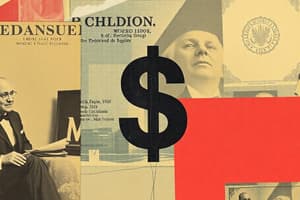Podcast
Questions and Answers
What is the primary objective of the Bangko Sentral ng Pilipinas (BSP) when utilizing monetary policy tools?
What is the primary objective of the Bangko Sentral ng Pilipinas (BSP) when utilizing monetary policy tools?
- Foreign investment attraction
- Economic growth acceleration
- Increased bank profitability
- Price and financial stability (correct)
What happens when the BSP sells government securities in the open market?
What happens when the BSP sells government securities in the open market?
- It increases banks' reserve requirements
- It decreases the interest rates
- It injects liquidity into the banking system
- It absorbs liquidity from the banking system (correct)
How does an increase in the reserve requirement affect banks' lending activities?
How does an increase in the reserve requirement affect banks' lending activities?
- It has no impact on lending
- It reduces banks' lending activity (correct)
- It allows banks to lend at lower interest rates
- It encourages banks to lend more
What effect does lowering the overnight reverse repurchase (RRP) rate have on the economy?
What effect does lowering the overnight reverse repurchase (RRP) rate have on the economy?
What is the purpose of the Term Deposit Facility (TDF) utilized by the BSP?
What is the purpose of the Term Deposit Facility (TDF) utilized by the BSP?
What occurs when the BSP lowers the reserve requirement ratio?
What occurs when the BSP lowers the reserve requirement ratio?
Which tool does the BSP NOT use to influence money supply in the economy?
Which tool does the BSP NOT use to influence money supply in the economy?
What is the impact of raising the policy interest rates by the BSP?
What is the impact of raising the policy interest rates by the BSP?
What is the primary purpose of the Term Deposit Facility (TDF)?
What is the primary purpose of the Term Deposit Facility (TDF)?
Which of the following describes the Special Deposit Account (SDA)?
Which of the following describes the Special Deposit Account (SDA)?
How does the BSP primarily use the Rediscounting Facility?
How does the BSP primarily use the Rediscounting Facility?
What is the main goal of the BSP's foreign exchange operations?
What is the main goal of the BSP's foreign exchange operations?
What does moral suasion refer to in the context of the BSP?
What does moral suasion refer to in the context of the BSP?
What is one of the key features of the Special Deposit Account?
What is one of the key features of the Special Deposit Account?
What impact does the BSP's purchase of foreign currency have on the economy?
What impact does the BSP's purchase of foreign currency have on the economy?
Which of the following describes the main goal of inclusive growth as per BSP's perspective?
Which of the following describes the main goal of inclusive growth as per BSP's perspective?
Flashcards are hidden until you start studying
Study Notes
Central Bank of the Philippines (BSP)
- BSP aims for price stability and financial stability through various monetary policy tools.
Tools of Monetary Policy
Open Market Operations
- Involves buying or selling government securities to adjust liquidity in the banking system.
- Selling securities absorbs liquidity (contractionary policy); buying injects liquidity (expansionary policy).
Reserve Requirement
- The reserve requirement ratio dictates the percentage of deposits that banks must retain in reserves.
- Increasing the reserve requirement restricts money supply (contractionary); decreasing it boosts money supply (expansionary).
- Effective June 30, 2023, reserve requirements were set at:
- Universal Banks/Commercial Banks: 9.5% for demand deposits, NOW accounts, savings deposits.
- Digital Banks: 6% for the same categories.
Policy Interest Rates
- BSP uses overnight reverse repurchase (RRP) rates to guide monetary policy stance.
- Lowering interest rates supports borrowing and spending (expansionary); raising rates helps control inflation (contractionary).
Term Deposit Facility (TDF)
- Used to manage excess liquidity in the financial system, allowing banks to deposit surplus funds for a fixed term.
- TDF offers auctions for deposits with tenors of 7, 14, and 28 days, attracting funds and managing short-term interest rates.
Special Deposit Account (SDA)
- Allows banks to place excess reserves at the BSP to manage liquidity and influence money market rates.
- Functions as a settlement account for special funds, facilitating deposits and withdrawals as per regulation.
Rediscounting Facility
- Enables banks to borrow from the BSP using eligible loans as collateral, offering liquidity for temporary needs.
- Supports banks in refinancing loans extended to clients, enhancing overall money supply.
Foreign Exchange Operations
- BSP intervenes in the foreign exchange market to stabilize the peso's value via buying and selling currencies.
- Purchases of foreign exchange paid in pesos increase peso circulation, which can influence inflation and economic stability.
Moral Suasion
- Utilizes influence rather than regulation to guide banks toward certain practices, encouraging adherence to BSP policy directions.
Inclusive Growth
- BSP's monetary policies target sustainable economic growth that creates jobs, reduces poverty, and improves access to essential services in health and education.
- Focuses on providing equal opportunities and empowering individuals through education and skill development.
Studying That Suits You
Use AI to generate personalized quizzes and flashcards to suit your learning preferences.




